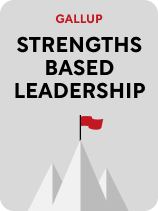
What are the four qualities of a good leader? How can you optimize the strengths of your team?
In Strengths Based Leadership, Tom Rath and Barry Conchie argue that the best leaders invest in their personal strengths while building a diverse team to make up for their weaknesses. This way, each individual contributes unique strengths to create a well-rounded team.
Read below for a brief Strengths Based Leadership book overview.
Strengths Based Leadership by Tom Rath and Barry Conchie
In the Strengths Based Leadership book, Tom Rath and Barry Conchie dispel the myth that leaders should strive to be well-rounded and instead argue that the best leaders focus on their personal strengths while building a supportive team that fills in for their weaknesses. The authors compile data on effective leaders and their teams from across the globe to argue that maximizing strengths is the optimal approach for improving your team’s productivity and satisfaction.
Rath is a workplace researcher who spent more than a decade in charge of leadership consulting at Gallup, a business research and consulting company. He’s also the author of multiple New York Times best sellers, including StrengthsFinder 2.0 and How Full Is Your Bucket?. Conchie is a business consultant who previously worked as Senior Scientist for Gallup’s executive leadership consulting program.
In this book, Conchie and Rath extend the conversation on strengths beyond the scope of StrengthsFinder 2.0 to explore how investing in your strengths can improve you as a leader. After gathering data from interviews with 20,000 leaders and 10,000 employees across the globe, they discovered leadership virtues that help meet a team’s needs and found that investing in strengths is the surest way to achieve success.
In the first section of this guide, we’ll cover the four leadership qualities that Gallup research has found to be critical for creating a loyal team. In section two, we’ll unpack Conchie and Rath’s argument that leading well requires that you maximize your personal strengths and build a balanced team around you. We’ll also compare Conchie and Rath’s ideas to other leadership approaches and add additional nuances and actionables to help you capitalize on your (and your team’s) strengths more effectively.
A Note About the StrengthsFinder Assessment
As a pairing to the information shared in this book, the authors recommend taking Gallup’s CliftonStrengths online assessment (formerly known as StrengthsFinder) to discover and leverage your unique strengths. This program is available to purchase on Gallup’s website or by applying a free code provided with each Strengths Based Leadership book.
Gain Respect by Demonstrating Leadership Qualities
Before you can lead anyone successfully, your team must respect you, and that starts with having certain universal qualities. Conchie and Rath explain that if your team respects you, they’ll be willing to follow your lead. So, before you analyze and capitalize on your strengths and those of your team, you must first be a person who’s worthy of respect.
In this section, we’ll explore the four qualities of a leader that command respect: being caring, honest, steady, and optimistic.
Good Leaders Are Caring
Gallup research shows that people who feel their leaders care about them are more likely to stay with that leader, have more engaged customers, be more productive at work, and create more profit for their company. The authors explain that leaders who exhibit care inspire in their team reciprocal care for the company.
For example, Standard Chartered’s chairman, Mervyn Davies always suggested that his employees put their families first and promoted the emotional well-being of his team through several wellness programs. In turn, he says his employees love their roles and are loyal to his company.
Good Leaders Are Honest
As a leader, it’s also important for you to be honest with your team. To Conchie and Rath, honesty means being true and transparent about good and bad news that involves your team. If your team doesn’t trust that you’re being truthful with them, they’re significantly less likely to be engaged with your mission. One Gallup study showed there was just a 1-in-12 chance that followers would be engaged with their work if they didn’t trust their leaders. In contrast, followers who trust their leaders have a more than 1-in-2 chance of being engaged.
Relationships built on honesty will also increase your team’s efficiency. Gallup research has found that people who know and trust each other well work better together. This is because when you have a relationship with someone, you don’t have to spend time trying to figure out how to engage with them—you can just get right down to business.
For example, if you’re a manager delivering negative feedback to a new employee, you might not know what style of communication they’re most receptive to. As a result, your conversation could backfire and you end up with a disgruntled or confused employee. On the other hand, if you’re delivering feedback to an employee you have an established, honest relationship with, the directive will likely land on the first conversation and you can immediately move forward.
Good Leaders Are Steady
The next virtue that good leaders contribute to their teams is steadiness. Steadiness gives your team peace of mind and lets them know that you and the company are going to consistently support them during times of struggle. This means you should have steady values, but you should also strive for steadiness in a practical, financial sense. The authors explain that people want to feel their jobs are secure. When people feel secure, they perform better: Gallup research shows that when people feel confident in their company’s financial future, they are nine times more engaged with their work.
To help your employees feel like they’re sailing on a steady ship, be transparent about the company’s health, its goals, and your progress toward them. This will not only clear up any uneasiness about the company’s financial status with your employees, which will give them a sense of stability about their careers, but it will also give them a clearer sense of the role they play in helping the company succeed.
Good Leaders Foster Optimism
Steadiness helps people feel secure in the short term, but optimism gives people a sense of security and excitement for the future. If people feel positive about the future of your team, they’ll perform better. One Gallup study found that workers who felt enthusiastic about the future of their work life had a 69% chance of being highly engaged with their work, whereas workers who did not feel excited about their future had less than a 1% chance of being highly engaged. Optimism produces these results because it gives people something to look forward to, and it keeps something positive in mind when the present becomes difficult.
On the other hand, when leaders are busy responding to problems all the time, it shows their followers that they aren’t in control of the situation, which can influence people to lose confidence in them. Conchie and Rath explain that most leaders spend the majority of their time responding to problems rather than planning improvements for the future and fostering optimism throughout their team. There are two reasons that leaders react more than plan:
First, we live in a work culture that rewards problem-solving short-term issues more than innovation. Second, solving immediate issues is easier than thinking of large-scale, preventative plans or future improvements that may not manifest until years later.
Maximize Your Team’s Strengths
Now that you know which qualities all leaders should have, we’ll discuss how you can optimize your team by maximizing your strengths and encouraging the strengths of your team members.
You should strive to fulfill all of the qualities of a good leader. However, the authors emphasize that you shouldn’t aim for excellence in all of the strength categories we’ll discuss in this section. If you try to be strong in every area, you won’t be very proficient at any of them. Instead, you should capitalize on your innate talents and build a well-balanced team to fill in the gaps around you.
To unpack Gallup’s leadership philosophy, we’ll discuss why committing to your strengths and the strengths of others leads teams to success. Then we’ll explore the four strengths your team should have and how to make the most of each type.
Know Your Strengths and Stick to Them
Gallup research concludes that all good leaders know their strengths and apply them well. By doing this, you’ll be able to proficiently execute the tasks you’re skilled at without causing trouble in areas you aren’t well-suited for. In contrast, if you don’t know your strengths and weaknesses, your team may suffer for it. For example, something you think you do well you might actually do poorly, which can create more problems than help for your team. Thus, a lack of self-awareness can cause your employees and customers to be unhappy and stressed.
The authors categorize people’s natural strengths into four themes: executing, relationship-building, influencing, and strategic thinking.
Strength #1: Executing
People who execute can bring ideas to fruition, doing whatever it takes to get something done. There are a variety of qualities someone may have that help them excel in this category. For example, they may possess discipline to help them stay on track toward a goal, a sense of personal pride in working hard and achieving things, or a sense of responsibility for their team’s success.
To demonstrate what an executor looks like in action, the authors share the success story of Wendy Kopp, founder of an education-focused nonprofit called Teach For America. Kopp exemplifies the executing theme with her dominant characteristics of achievement and responsibility. After realizing the lack of quality education available to underprivileged children in the US, Kopp felt a personal sense of responsibility to create education opportunities. She worked persistently to organize a team of talented people and has now gathered hundreds of millions of dollars in funding.
Strength #2: Influencing
A person who influences can get others on board with their ideas. They possess qualities such as confidence, persuasion, and the ability to impress others. For example, you may exude so much confidence when you step up to take control of a project that your team feels convinced you’re capable of succeeding, so they support you. To convince people who aren’t as easily swayed, you may have an instinct for knowing what team members or clients want to hear or see to help you get through to them.
For example, the president of the Ritz-Carlton Hotel Company, Simon Cooper, knew his company’s strength was customer service and he capitalized on this to expand its influence. He confidently showed off his team to guests, which won him loyal clients. In one case, he invited the musician, Bono, to accompany him to a meeting with the hotel’s housekeeping staff. Cooper believed so strongly in his team’s excellent service that he broadened the company’s offerings to include private, luxury residences. Although many people questioned this risky expansion of the brand, Cooper’s confidence in his company won him many buyers, and the venture was successful.
Strength #3: Relationship-Building
Relationship-building is what helps your team perform as a cohesive whole. Conchie and Rath characterize this strength with sub-qualities such as optimism and compassion. For example, if you’re a relationship builder, you may be able to keep your team’s spirits up during a difficult day, which ultimately helps them perform better and complete the necessary objective. You’re also able to relate to individuals and mentor them to help them feel included and valuable to the team, which will help them work better together.
We’ll explore what relationship-building looks like by examining the success of Mervin Davies, a former CEO of Standard Chartered. He credits his success to his investment in relationships. In particular, he emphasizes a few relationship-building habits:
1. By communicating honestly and openly with his employees about the decisions he made for his company, he earned their trust, which is essential for good relationships.
2. Davies also trusted his employees by empowering them with responsibility and freedom. By knowing his own capabilities and the capabilities of people around him, he was able to assign people to tasks they’re suited to handle and free himself to do what he does best as an executive, coaching people.
3. By listening to his team, he got to know their strengths and deepened his relationships with them. This way, he knew how to empower individuals on his team more effectively.
Strength #4: Strategic Thinking
Strategic thinkers help their teams grow by analyzing performances and suggesting possibilities for improvement. Conchie and Rath explain that this strength involves being analytical and effective at consultation. For example, if you’re a strategic thinker, you may have an eye for noticing inefficiencies in your team’s performance and formulating an alternative game plan that saves time and increases productivity.
To show what strategic thinking looks like in practice, the authors point to Best Buy’s CEO, Brad Anderson. Anderson started as a sales associate at the Minneapolis-based electronics retailer that would eventually become Best Buy, and as the company grew, he ascended the ranks to CEO. His keys to success are his enthusiasm for learning and ability to ask great questions to uncover critical information. For example, he questioned whether a commission-based sales model was best for their stores, and after surveying customers, he realized this model made customers feel pressured by sales associates. So, he adopted a more relaxed model of browse shopping, where customers could shop fully stocked items at their leisure. This model was widely successful and was adopted by many other retailers soon after.

———End of Preview———
Like what you just read? Read the rest of the world's best book summary and analysis of Gallup, Tom Rath, and Barry Conchie's "Strengths Based Leadership" at Shortform.
Here's what you'll find in our full Strengths Based Leadership summary:
- Why good leaders don't necessarily need to be well-rounded
- Why you should build a diverse team to fill in your weaknesses
- The four qualities of a leader that command respect






